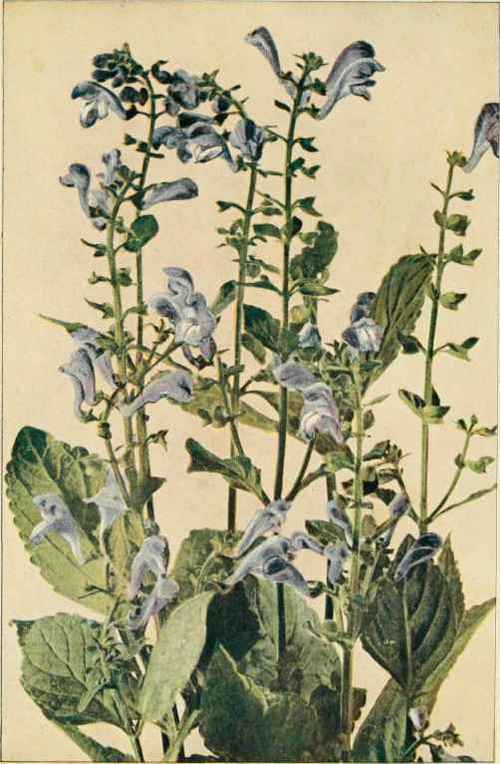Mad-Dog Skullcap Or Helmet-Flower; Mad-Weed; Hoodwort (Scutellaria Lateriflora) Mint Family
Description
This section is from the book "Nature's Garden", by Neltje Blanchan. Also available from Amazon: Nature's Garden; An Aid To Knowledge Of Our Wild Flowers And Their Insect Visitors.
Mad-Dog Skullcap Or Helmet-Flower; Mad-Weed; Hoodwort (Scutellaria Lateriflora) Mint Family
Flowers - Blue, varying to whitish; several or many, 1/4 in. long, growing in axils of upper leaves or in 1-sided spike-like racemes. Calyx 2-lipped, the upper lip with a helmet-like protuberance; corolla 2-lipped; the lower, 3-lobed lip spreading; the middle lobe larger than the side ones. Stamens, 4, in pairs, under the upper lip; upper pair the shorter; one pistil, the style unequally cleft in two. Stem: Square, smooth, leafy, branched, 8 in. to 2 ft. high. Leaves: Opposite, oblong to lance-shaped, thin, toothed, on slender pedicles, 1 to 3 in. long, growing gradually smaller toward top of stem. Fruit: 4 nutlets.
Preferred Habitat - Wet, shady ground.
Flowering Season - July - September.
Distribution - Uneven throughout United States and the British Possessions.
By the helmet-like appendage on the upper lip of the calyx, which to the imaginative mind of Linnaeus suggested Scutellum (a little dish), which children delight to spring open for a view of the four tiny seeds attached at the base when in fruit, one knows this to be a member of the skullcap tribe, a widely scattered genus of blue and violet two-lipped flowers, some small to the point of insignificance, like the present species, others showy enough for the garden, but all rich in nectar, and eagerly sought by bees. The wide middle lobe of the lower lip forms a convenient platform on which to alight; the stamens in the roof of a newly opened blossom dust the back of the visitor as he explores the nectary; and as the stamens of an older flower wither when they have shed their pollen, and the style then rises to occupy their position, it follows that, in flying from the top of one spike of flowers to the bottom of another, where the older ones are, the visitor, for whom the whole scheme of color, form, and arrangement was planned, deposits on the sticky top of the style some of the pollen he has brought with him, and so cross-fertilizes the flower. When the seeds begin to form and the now useless corolla drops off, the helmet-like appendage on the top of the calyx enlarges and meets the lower lip, so enclosing and protecting the tiny nutlets. After their maturity, either the mouth gapes from dryness, or the appendage drops off altogether, from the same cause, to release the seeds. Old herb doctors, who professed to cure hydrophobia with this species, are responsible for its English misnomer.
Perhaps the most beautiful member of the genus is the Showy Skullcap (S. serrata), whose blue corolla, an inch long, has its narrow upper lip shorter than the spreading lower one. The flowers are set opposite each other at the end of the smooth stem, which rises from one to two feet high in the woods throughout a southerly and westerly range. As several other skullcaps have distinctly saw-edged leaves, this plant might have been given a more distinctive adjective, thinks one who did not have the naming of 200,000 species!
Above dry, sandy soil from New York and Michigan southward the Hairy Skullcap (S. pilosa) lifts short racemes of blue flowers that are only half an inch long, and whose lower lip and lobes at either side are shorter than the arched upper lip. Most parts of the plant are covered with down, the lower stem being especially hairy; and this fact determines the species when connected with its rather distant pairs of indented, veiny leaves, ranging from oblong to egg-shaped, and furnished with petioles which grow gradually shorter toward the top, where pairs of bracts, seated on the stem, part to let the flowers spring from their axils.

Hyssop Skullcap. (Scutellaria integrifolia.)
The Larger or Hyssop Skullcap (S. integrifolia) rarely has a dent in its rounded oblong leaves, which, like the stem, are covered with fine down. Its lovely, bright blue flowers, an inch long, the lips of about equal length, are grouped opposite each other at the top of a stem that never lifts them higher than two feet; and so their beauty is often concealed in the tall grass of roadsides and meadows and the undergrowth of woods and thickets, where they bloom from May to August, from southern New England to the Gulf of Mexico, westward to Texas. (Illustration, p. 56.)
This tribe of plants is almost exclusively North American, but the hardy Marsh Skullcap, or Hooded Willow-herb (S. galericulata), at least, roams over Europe, and Asia also, with the help of runners, as well as seeds that, sinking into the soft earth of swamps and the borders of brooks, find growth easy. The blue flowers which grow singly in the axils of the upper leaves are quite as long as those of the larger and the showy skullcaps; the oblong, lance-shaped leaves, which are mostly seated on the branching stem, opposite each other, have low teeth. Why do leaves vary as they do, especially in closely allied species? "The causes which have led to the different forms of leaves have been, so far as I know," says Sir John Lubbock, "explained in very few cases: those of the shapes and structure of seeds are tolerably obvious in some species, but in the majority they are still entirely unexplained; and, even as regards the blossoms themselves, in spite of the numerous and conscientious labors of so many eminent naturalists, there is as yet no single species thoroughly known to us."
Continue to:




